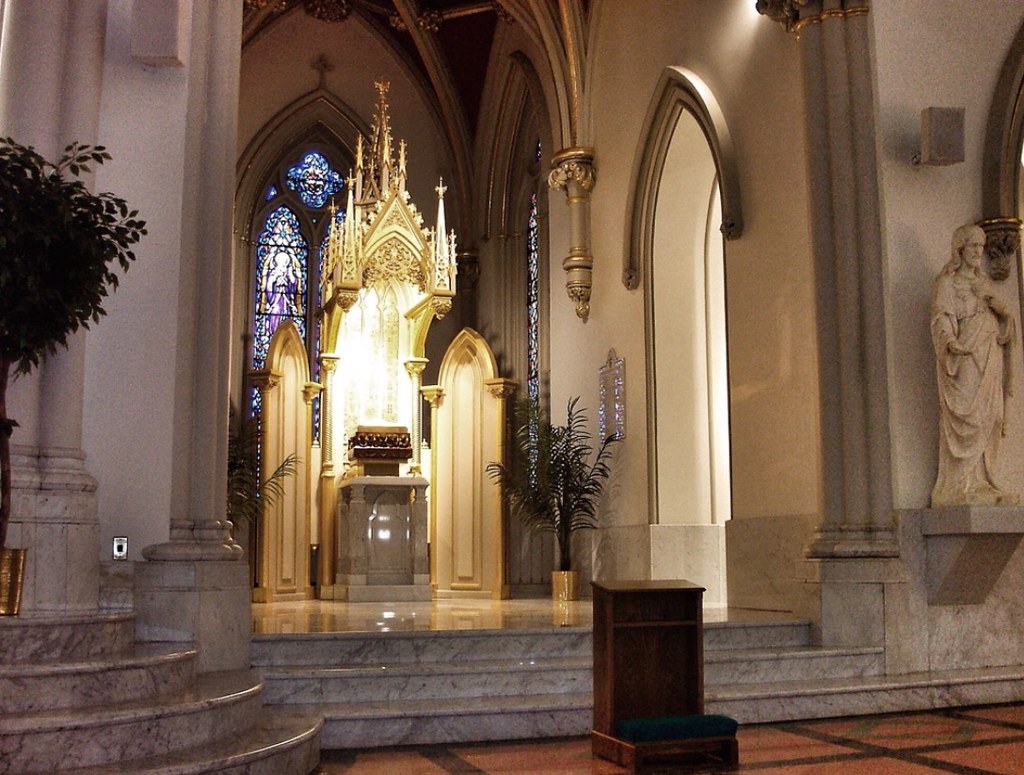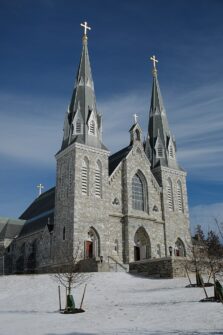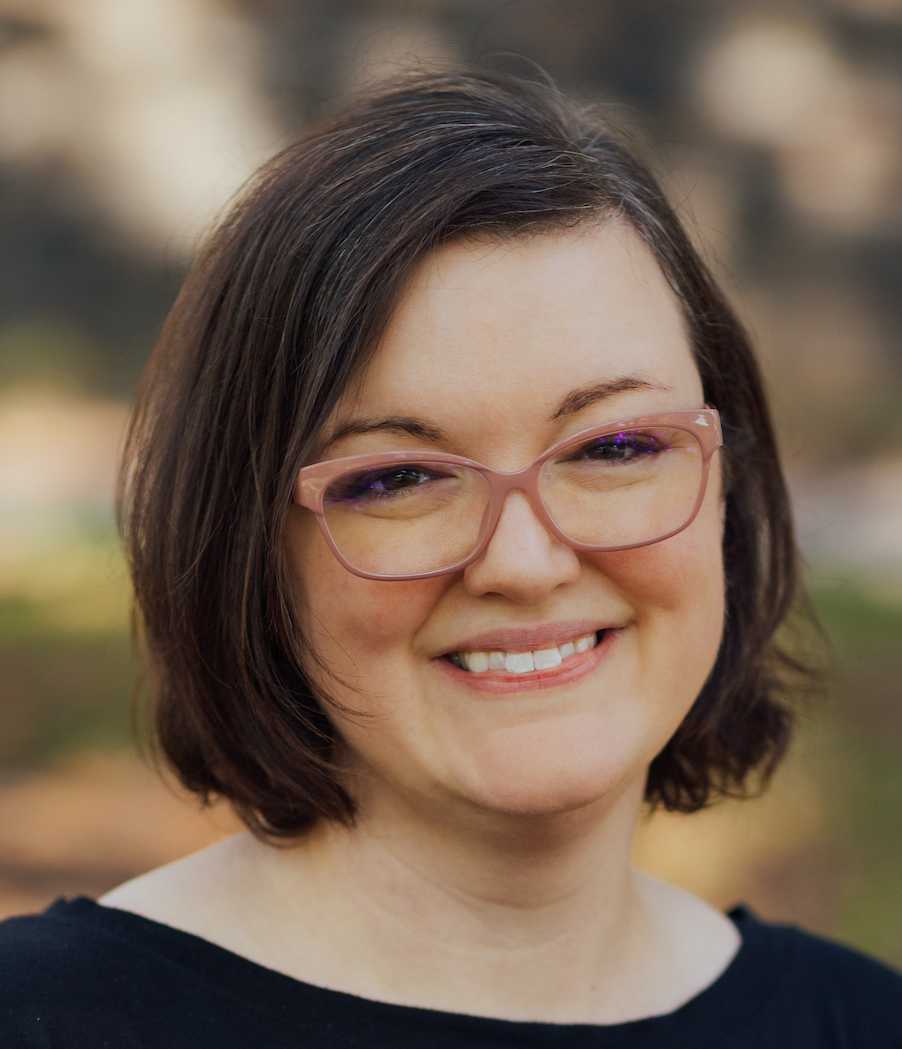
“Land relations always already play a central role in all sciences, anticolonial and otherwise.” (Max Liboiron [Red River Métis/Michif], Pollution is Colonialism, 6).
Tabernacles—artistic Catholic boxes that house the physical presence of Jesus in Catholic Churches—are one material location that obscures the presence of Land in Catholic theology. This essay illustrates how Liboiron’s assertion about Land relations in the epigraph above also applies to Catholic theology and religious practice. Catholics practice Land relations wherever Catholics practice Catholicism. Catholic theology likewise utilizes specific Land relations in its theorizing.
The tabernacle was a focal point of the conservative traditionalist experience of my Catholic childhood. It was how my father defined our faith for us. Dad consistently emphasized the supposed spiritual lack of Protestant churches—churches without tabernacles. Whenever we drove by one, my Dad would point and say, “that’s an empty church.” The cadence of this interaction (at least in my memory) echoes that famous Oprah episode where everyone gets a car: “that’s an empty church, and that’s an empty church, and that’s an empty church!” Empty because there wasn’t a tabernacle. Empty because God was not physically, and by extension, spiritually, with Protestants.
While recently ruminating on these childhood moments, I started to think about Catholic tabernacles—made of what appears as gold, but is actually likely bronze; sitting on what looks like marble, but may actually only be wood with marble overlay. Material opulence (real or perceived) nestles alongside the Catholic belief in divine eucharistic presence. It is juxtaposed with my Dad’s connection between material privation and divine absence or emptiness.
Certainly, this binary of opulence versus privation, and the presence (or not) of the divine invokes an ecumenical discussion, perhaps illustrating how the spatial aesthetics birthed during the Protestant Reformation remain salient for Christians today. Taking that route might bring us to Dennis Doyle, a White male Catholic theologian from my Dad’s generation, who elaborates on the Catholic anti-Protestant ideologies of the mid-twentieth century: “Our religious faith bonded us together in the face of a hostile Protestant world becoming ever more secularized.”
But what if, instead of referencing the Protestant Reformation, one percolates this notion of privation and absence further back in history through the Doctrine of Discovery? In these series of papal bulls written for the benefit of the fifteenth-century Catholic monarchies of Portugal and Spain, one sees a bonding together of Catholic political theology against a different hostile other. A pagan, savage other, perhaps a nobly savage other. An other, as Cherokee philosopher Brian Burkhart has argued, perceived as “solid waste to be filtered from the land in order for the settler colonial to acquire the land itself” (27).
Indigenous Land and the Catholic Doctrine of Discovery
Thinking about tabernacles alongside the Doctrine of Discovery, the mind’s eye begins to travel beneath the heavy bronze, the marble overlay, the shiny floor, and the concrete foundation, to the dirt—the land—that the tabernacle sits on.
In the United States this is stolen land. Stolen through genocide, trickery, forced displacement and assimilation, and soaked in the blood of that genocide and the enslavement and murder of Black bodies. The entire premise of the Christian Doctrine of the Incarnation is that the uncreated God became creation. Catholic tabernacles ensconce the physical resting place of Jesus in the shape of the eucharistic wafer. As illustrated by the Vatican’s re-released directive on gluten-free hosts, materiality and specificity are not arbitrary or less relevant aspects to Catholic incarnational and eucharistic theologies. Indeed, material specificity infuses them. By extension then, the material reality, history, and contemporary use of Indigenous land supporting the physical presence of Jesus in the eucharistic wafer, matters. This begs a theological question: What does it mean for Jesus to be materially and physically supported by land soaked in the blood of enslavement and genocide? Does God mind?
Indeed, in addition to the tabernacle, there is a special sink, a sacrarium, inside the sacristies of Catholic Churches which ensures that “the natural elements [of the eucharist] are returned to the earth in a more dignified manner than if they were drained into a holding tank or sewer where they would be mingled with sewage.” Jesus cannot be mixed with human and other waste. Yet, in the U.S., all sacrariums drain into Indigenous Land. Drawing again on Max Liboiron, I name Land here as a “unique entity,” a place-based, spirited network of stories, kin, and relationships of more-than-human and human people that transcend time, but are firmly grounded in place.
What does it mean for Jesus to be materially and physically supported by land soaked in the blood of enslavement and genocide?
I myself write this from the Lenapehoking, the Land of the Lenape peoples. First stolen by William Penn’s sons in their crooked dealings with the Lenape in the 1600s, the Lenapehoking writ large was the home of what today includes a diaspora of six federally recognized tribes, as well as three state recognized tribes spread out in New Jersey and Delaware, and one community in Pennsylvania fighting for state recognition. Indigenous communities in the Lenapehoking, and the United States more broadly, are still resisting colonization by non-Indigenous political entities such as the Catholic Church. The theological question of God’s desires for the worship spaces of the body of Christ—bound up in political realities dictating whose religion is recognized, and who has access to land and why—are always political ones. Indeed, regardless of how one theologizes God’s desires, the question of Land and access persist as stubborn practical remainders. How might U.S. Catholics begin to converse with the particulars of Catholic spaces—churches and universities in particular—whose very presence have required Indigenous genocide and Black enslavement?
Some scholars dealing with similar issues, for example theologians in South Africa, have turned to spatial justice ethics. Most articulations of spatial justice ethics draw upon the work of Polish-American geographer Edward Soja and his foundational text, Seeking Spatial Justice (2010). Via an ethnographic exploration of grassroots organizing by the Bus Riders Union in Los Angeles, Soja attends to spatial justice through what is called “the spatialized turn”—an inclusion of space in academic theory and method which insists that space is not merely created by culture, but also acts as a creator of it. Soja explains that the spatialized turn shifts the focus from space as subordinate to history to articulations of history and spatiality where they each “take on equal and interactive significance” (15).
The Lenapehoking and Villanova University
An example of the spatialized turn from the Lenapehoking provides a helpful anchor to this theory.
Villanova University is a Catholic school founded by the Order of St. Augustine just outside of Philadelphia. School grounds include the St. Thomas of Villanova church (and tabernacle), and two other worship spaces with tabernacles. The Villanova campus hosts what Villanova terms the “Nova Nation.” This “nation” is composed of both current students and alumni, as well as staff, faculty, and administrators: in other words, the nova nation is relational. Anyone who has an extended relationship with the campus institution is included in its nation.
Prior to the spatialized turn, one would understand the space which Villanova inhabits as primarily a catalyst for the history of the Nova Nation. The school was founded in 1842, and generations of Wildcats have “continued Villanova’s tradition of excellence in academics and athletics.” A theo-political imaginary where space and history do not involve each other much clouds the ongoing structure of settler-colonialism—a structure based on the theft of Indigenous land. Land-become-property benefits White and other settlers, via, for example, public land-grant universities, or the private purchase of land by the Augustinians to create the Villanova Campus. These universities foster the economic success of settler students at the cost of Indigenous peoples. The imaginary that Soja critiques perceives the land on which the Villanova Wildcats walk as a consequentialist’s tool. It is a means directed solely to the ends of academic and athletic achievement for settler communities.
But via the spatialized turn—when space and history inform and constitute each other—land as a tool of achievement shifts. Now, one sees the Land on which Villanova sits as shaped specifically by the enslavement of Black people known only as Jack and Chloe (legacies unearthed in the work of Colin McCrossan on Villanova’s Rooted Project). The reality of Jack and Chloe’s enslavement continues to shape the life of today’s Nova Nation. It emerges, for example, in the anti-Black experiences articulated in the @BlackVillanova Instagram page, and in the continued presence of the Sigma Pi Epsilon fraternity house called “The Plantation.” In other words, Jack and Chloe and their enslavement continue to undergird the Nova Nation. Their forced labor made the Villanova campus possible, and the anti-Black White supremacy structuring their enslavement continues to form campus today. Indeed, the continued lack of any land acknowledgement (at minimum) or substantive relation with any members of the various Lenape nations (at best) illustrates how the Villanova campus benefits from and requires the continuation of the myths of the “Last Indian” and “None Left Behind” fallacies in order to maintain its presence in the Lenapehoking.

Ultimately, Villanova illustrates what Soja argues: humans not only shape their environment, they are also shaped by it. Indeed, Standing Rock Sioux scholar Vine Deloria Jr., writing almost forty years before Soja, states, “Spatial thinking requires that ethical systems be related directly to the physical world and real human situations, not abstract principles… space must in a certain sense precede time as a consideration for thought” (72). Thus, refracted back through the lens of Deloria, the “recent” spatialized turn evinced by Soja illustrates an ongoing reality of relationships and structures— structures that do not conform to Euro-American linear progressive notions of time.
This understanding of space and time clears the ground for Patrick Wolfe’s work cited above, which names settler colonialism as an ongoing structure, rather than as a past event. If settler colonialism were merely a point on the historical timeline, then the tabernacle in St. Thomas of Villanova church can be simply an apolitical sacred space—once an unfortunate site of violence and/or theft in the distant past. But acknowledging settler colonialism as an ongoing event suggests otherwise. If settler colonialism persists in the very structures of land ownership and use, then Jesus does not drain through Villanova sacrariums into Augustinian, Catholic, or even U.S. sacred ground. Just as racism and White supremacy braid together within the Nova Nation, settler-colonial violence and Catholic sacrality tangle in the space of St. Thomas of Villanova Church.
Certainly, learning about Jack and Chloe, and the history of the Lenapehoking, is an important first step for the “Nova Nation.” Yet, this learning is not enough. As Jeremy Sorgen contends in his article in this series, “The study of Indigenous ontologies allows settlers to live toward alternative land relations epistemically without transforming their relations politically and materially… . Change is cognitive, not structural.” The continued presence of “The Plantation,” and the lack of relationship between Lenape peoples and Villanova, bears out Sorgen’s analysis.
From Emptiness to Unknowing: Catholic Land Return
Approaching the violent settler-colonialism of U.S. Catholic Churches through the lens of spatial justice ethics thus seems rather promising at first. The inclusion of space/land as a constitutive and ongoing element of culture forces academics and theologians “to dissect the myth of spatial neutrality” as I have done here (Soja, 181). However, in spatial justice ethics, land is understood primarily as space. The land/space framework, particularly for Soja, instantiates humanity as the prime mover, the anthropocentric big bang initiating the history/space relationship. In this anthropocentric relationship, theorists and theologians preserve the debunked prerogative of Euro-American history/temporality. Land, though not neutral, remains a space (the space?) where injustice was once enacted by humans, injustice that foundationally influences the culture today, as with the Villanova example above. Yet, in spatial justice ethics, land is also the contemporary space where, with the right orientation, discernment, and positioning of use, justice can ensue. To put it succinctly, Land becomes instrument. While it can shape subsequent history, Land here primarily functions as a tool for human use and thus, human justice. Within this relational framework of space/land as interchangeable instruments that require human reorientation toward justice, the logic of terra nullius persists. As Liboiron cites British Australian education scholar Raewyn Connell, terra nullius is “invoked every time we try to theorise the formation of social institutions and systems from scratch, in a blank space” (Liboiron, 21). The accusation of emptiness my Dad claimed for the Protestants echoes here. The land Villanova sits on was considered, like the allegations against Protestant churches, a void space without God. A space waiting to be filled with Catholic divinity, sacrality, and achievement. What options do theologians and Catholic peoples have to address these ongoing terra nullius logics?
Just as racism and White supremacy braid together within the Nova Nation, settler-colonial violence and Catholic sacrality tangle in the space of St. Thomas of Villanova Church.
Peruvian Anthropologist Marisol De La Cadena provides a helpful pause for the spatialized turn. As she writes of her ethnographic work with an Indigenous Quechua family in Peru, “I could access tirakuna [earth beings] only through Mariano and Nazario and perhaps other runakuna [what Quechua people call themselves. Pejoratively called “Indians” by non-runakuna]. With my usual epistemic tools, I could not know Ausangate—not even if I got lucky” (xxv). De La Cadena’s articulation of the sovereignty of Ausangate, an “earth-being that is also a mountain,” (xxvii) unknowable except to their runakuna, highlights the incommensurability between herself, the runakuna, and the earth-beings of the Peruvian Andes. She offers a thread of praxis that Christian theology could mimic as part of an attempt to take Land seriously.
Instead of the assertion and practice of Land’s supposed emptiness, the theologies of the Church might admit, like de la Cadena, that they are unable to know Lenapehoking and the other Indigenous Lands of the United States. And that this unknowing, coupled with the Church’s role as the progenitor of the Doctrine of Discovery, requires not a confession of past sins, but the dismantling of ongoing ones. As de la Cadena points out, “Our worlds were not necessarily commensurable, but this did not mean we could not communicate” (xxv). The use of Jack and Chloe’s enslavement to build the Nova Nation requires an embrace of the relational nature of reparations as an overall undoing of anti-Black structures of oppression that includes, but is not limited to, economic reparations. The imposition of settler-colonialism as violence against the Land requires not just an exploration of right land usage per the tenets of spatial justice ethics, but a “communication” of decolonial political praxis rooted in the reality that the land is still Indigenous Land. St. Thomas of Villanova is Lenapehoking, not Augustinian Catholic.
How might the Catholic church, despite the incommensurability of Catholic theology and Land sovereignty, take on this work? What relationality might allow the eucharist, resting in its bronze tabernacle, to jettison its position as a God of genocide?
As Sorgen asserts of scholars, I assert of theologians and the Church.
It’s time for the Catholic Church to give the land back.

